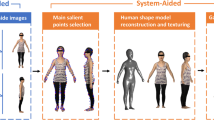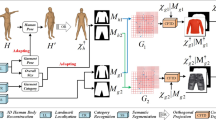Abstract
]Using computer-aided design system to design an elegant 3D garment for a virtual human is often tedious and labor-intensive. Moreover, the garment is usually designed for a reference human model and generally not fitted to other individuals, which largely reduces the reusability of existing 3D garments. In this paper, we introduce proxy mesh to fit 3D garment to another human model whose topology or shape is different from the garment’s reference human model. Firstly, a proxy mesh is generated for the reference human model and the specified human model respectively. Secondly, the garment is parameterized based on the proxy mesh of the reference model and an independent dataset is obtained. Thirdly, the dataset is decoded to the proxy mesh of the other human model and a roughly fitted garment is gained. Lastly, local shape constrains are enforced to the fitted garment and garment-body penetrations are resolved to get a well fitted garment. Our approach is efficient, simple to implement and is potential to be applied to existing applications such as virtual try-on and virtual clothing design.














Similar content being viewed by others
References
Baraff D, Witkin A (1998) Large steps in cloth simulation. Proceedings of SIGGRAPH’98, 43–54
Choi KJ, Ko HS (2002) Stable but responsive cloth. ACM Trans Graph 21:604–611
Cordier F, Seo H, Thalmann NM (2003) Made-to-measure technologies for an online clothing store. IEEE Comput Graph Appl 23:38–48
Decaudin P et al (2006) Virtual garments: a fully geometric approach for clothing design. Eurographics 25:625–634
Desbrun M, Schröder P, Barr A (1999) Interactive animation of structured deformable objects. Graphics Interface, 1–8
Fuhrmann A, Sobotka G, Gross C (2003) Distance fields for rapid collision detection in physically based modeling. Proceedings of Graphics on 2003, 58–65
Hasegawa S, Fujii N, Koike Y, Makoto S (2003) Real-time rigid body simulation based on volumetric penalty method. Proceedings of the 11th Symposium on Haptic Interfaces for Virtual Environment and Teleoperator Systems
Igarashi T, Hughes JF (2007) Clothing manipulation. Proceedings of the 15th ACM symposium on user interface software and technology, 91–100
Jing T, Jin Z, Ligang L, Zhigeng P, Hao Y (2012) Scanning 3D full human bodies using kinects. IEEE Trans Vis Comput Graph 18:643–650
Kim S, Park CK (2007) Basic garment pattern generation using geometric modelling method. Int J Cloth Sci Technol 19:7–17
Luo ZG, Yuen MMF (2005) Reactive 2D/3D garment pattern design modification. Comput Aided Des 37:623–630
Meng YW, Mok PY, Jin XG (2010) Interactive virtual try-on clothing design system. Comput Aided Des 42:310–321
Mori Y, Igarashi T (2007) Plushie: an interactive design system for plush toys. ACM Trans Graph 26:3
Terzopoulos D, Platt JC, Bar H (1987) Elastically deformable models. Comput Graph 21:205–214 (proc. SIGGRAPH’87)
Turquin E et al (2007) A sketch-based interface forclothing virtual characters. IEEE Comput Graph Appl 27:72–81
Umetani N, Danny M, Igarashi T, Grinspun E (2011) Sensitive couture for interactive garment modeling andediting. ACM Trans Graph 30:90
Volino P, Courchesne M, Thalmann NM (1995) Versatile and efficient techniques for simulating cloth and other deformable objects. SIGGRAPH’95 Conference Proceedings, 137–144
Volino P, Thalmann NM (2007) Stop-and-go cloth draping. Vis Comput 23:669–677
Wang CL, Chang KK, Yuen MF (2003) From laser-scanned data to feature human model: a system based on fuzzy logic concept. Comput Aided Des 35:241–253
Wang CL, Wang Y, Yuen MMF (2005) Design automation for customized apparel products. Comput Aided Des 37:675–691
Zhang D, Yuen MMF (2001) Cloth simulation using multilevel meshes. Comput Graph 25:383–389
Acknowledgment
The work presented in this paper was supported by NSFC Grant 61173124, 61170318 and 611332017.
Author information
Authors and Affiliations
Corresponding author
Rights and permissions
About this article
Cite this article
Zhang, M., Lin, L., Pan, Z. et al. Topology-independent 3D garment fitting for virtual clothing. Multimed Tools Appl 74, 3137–3153 (2015). https://doi.org/10.1007/s11042-013-1774-4
Published:
Issue Date:
DOI: https://doi.org/10.1007/s11042-013-1774-4




